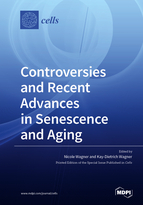Controversies and Recent Advances in Senescence and Aging
A special issue of Cells (ISSN 2073-4409). This special issue belongs to the section "Cellular Aging".
Deadline for manuscript submissions: closed (1 May 2022) | Viewed by 79405
Special Issue Editors
Interests: PPARs; cancer; development; angiogenesis; transcriptional regulation; tumor angiogenesis; mechanisms of tumor progression; cancer treatment
Special Issues, Collections and Topics in MDPI journals
Interests: vessel formation in development and disease; transcriptional control; epigenetics; cardiovascular disease
Special Issues, Collections and Topics in MDPI journals
Special Issue Information
Dear Colleagues,
Aging could be viewed as a gradual and continuous decline in the function of cells, tissues, or the whole organism resulting from genetic, external, and lifestyle-associated factors. Alternatively, aging might be perceived as dysregulation of “normal” developmental processes. Aging is the leading predictive factor of chronic diseases that account for most of the morbidity and mortality worldwide (e.g., neurodegeneration; cardiovascular, pulmonary, renal, and bone diseases; and cancers). Oxidative stress and reactive oxygen species generation, overproduction of inflammatory cytokines, activation of oncogenes, DNA damage, telomere shortening, and the accumulation of senescent cells are all widely accepted mechanisms contributing to aging. Senescence is mainly thought to be provoked by negative cellular stress, but might also be induced by physiological developmental stimuli. It was described 50 years ago in fibroblasts in culture, and is characterized as irreversible cell cycle arrest independent of quiescence and terminal differentiation. However, more recent observations suggest that the status of developmental and cancer senescent cells might not be irreversible. Aside from cell cycle arrest, senescent cells are characterized by morphological changes and molecular damage, metabolic alterations, and a specific secretory phenotype. The cyclin-dependent kinase inhibitors p16Ink4a, p19Arf, and p21Waf1/Cip1 have been implicated in senescence, but currently, no single marker is available to identify a cell as specifically senescent in vivo. One the one hand, senescent cells might contribute to embryonic tissue development and participate in tissue repair and tumor suppression. On the other hand they are involved in detrimental tissue decline during aging. Thus, the application of senolytic or senostatic drugs to halt or reverse age-related pathologies could represent an interesting therapeutic option. In several animal models, the elimination of senescent cells has been shown to promote healthy aging, while in a different model, the elimination of p16Ink4a-expressing cells resulted in the impairment of the health-span and liver disease. Given the pleiotropic actions of senescent cells, a deeper understanding is needed to develop further approaches and recommendations for healthy aging. All contributions shedding additional light and providing significant or provocative findings in these fascinating topics are welcome in this Special issue of Cells.
Dr. Nicole Wagner
Dr. Kay-Dietrich Wagner
Guest Editors
Manuscript Submission Information
Manuscripts should be submitted online at www.mdpi.com by registering and logging in to this website. Once you are registered, click here to go to the submission form. Manuscripts can be submitted until the deadline. All submissions that pass pre-check are peer-reviewed. Accepted papers will be published continuously in the journal (as soon as accepted) and will be listed together on the special issue website. Research articles, review articles as well as short communications are invited. For planned papers, a title and short abstract (about 100 words) can be sent to the Editorial Office for announcement on this website.
Submitted manuscripts should not have been published previously, nor be under consideration for publication elsewhere (except conference proceedings papers). All manuscripts are thoroughly refereed through a single-blind peer-review process. A guide for authors and other relevant information for submission of manuscripts is available on the Instructions for Authors page. Cells is an international peer-reviewed open access semimonthly journal published by MDPI.
Please visit the Instructions for Authors page before submitting a manuscript. The Article Processing Charge (APC) for publication in this open access journal is 2700 CHF (Swiss Francs). Submitted papers should be well formatted and use good English. Authors may use MDPI's English editing service prior to publication or during author revisions.
Keywords
- aging
- senescence
- development
- senolytics/senostatics
- p16Ink4a
- p19Arf
- p21Waf1/Cip1
- SASP
- tissue repair
- tumor suppression








